Preface
Grown originally in tropical America, guava was delivered by the Spanish to Europe and then the rest of the world. In 1694, Taiwan saw the first seeds of guava from the mainland China. In the very beginning, we only had wild species, which were called as “Ba-lah” by our ancestors, or “Foreign Shiliu,” as guava resembles the Chinese Shiliu and was passed from other countries. Later on, “Ba-lah” was changed to a more refined “guava” (pronounced in the Taiwanese language). The production saw a slow increase in the Japanese-colonized period. After the restoration of Taiwan, the area and production saw a slow yet steady growth. During the period of 1976~1986, our local farmers developed Thailand’s guava and Century guava. Since then, the area of guava plantation has seen a rapid increase. Thailand’s guava and Century guava are large-sized, crisp and chewy, and were very popular with the local peasants in the 1980s and 1990s. In 1989, Pearl guava and Crystal guava were both developed with huge success. Pearl guava is easy to grow and tastes very good, while Crystal guava has fewer seed; therefore, both were welcome by consumers. Thus the southern Taiwan made further efforts to renew the species. In 2006, the Fengshan Branch of Taiwan Agricultural Research Institute developed Emperor guava, which has a fuller pulp and tastes crispy and is better than the other species in some ways. Some other peasants tried to grow Emperor guava as a result, and the Emperor guava started to replace the status of Century guava. In recent years, Emperor guava and Crystal guava are both second species following Pearl guava, each occupying a 5% market.
TOP
Introduction to main species
Xizhou has seen a long process of alternation of species of guava plantation since the very beginning. The earliest species was local guava, which was followed by foreign species such as the Thailand’s guava and Century guava, and then renewed Pearl guava, Crystal guava, Perfume guava, and Red-heart guava. Presently Xizhou Township made Pearl guava the main species of its guava cultivation, with the acreage and production ranked as top place in the country.
| Species |
Features |
Photo |
Local guava |
Smaller size, with harder pulp and seeds. The whiter the skin, the sweeter the taste. Old Taiwanese saying goes that “Eating a guava makes excretion harder.” It was not good for digestion. The pulp round the seeds tastes unbelievably good, however. |
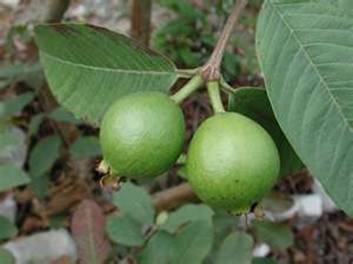 |
Thailand’s guava |
Larger size, yet less sweet. Only 1/4 of a guava would serve as a meal. |
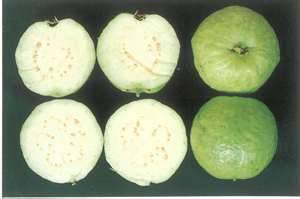 |
Century guava |
Smaller than a Thailand’s guava. Oval shape, light green color, uneven surface, with medium fiber amount. Very juicy and crisp. |
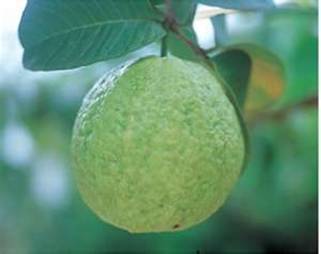 |
Crystal guava |
Fewer seeds, with a flatly round (nearly a hexagon) shape. The pulp is white, and tastes crisp and fresh. |
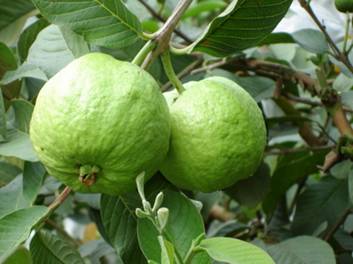 |
| Pearl guava |
Oval shape with light yellowish color of pulp. This species smells especially good. |
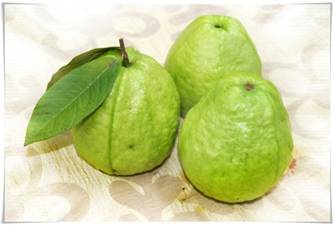 |
| Pine guava |
Pine guava blossoms in March, and the fruit can be picked in summer holidays. During the harvest season, large numbers of birds would gather round the tress, and the guava that was bitten by birds proved sweetest. |
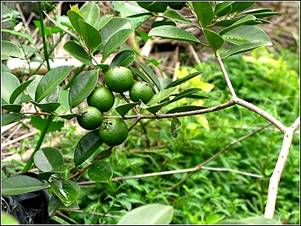 |
| Red-heart guava |
The vitamin C in a red-heart guava is especially high, with 455mg/100g compared to the100-300mg/
100g of ordinary guavas. In addition, red-heart guava has excessively high ash content and iron too. The leaves or guava slices can replace tea once they are sunbaked; it is called “guava tea”. Guava is good to human health and can be eaten as fruit or juice or tea.
|
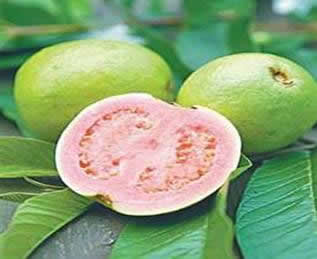 |
TOP
Nutritional value of guava
Nutrients: Guavas are rich in minerals such as iron, phosphorus and calcium. The seeds of guavas are especially rich in iron, which are ranked as top of tropical fruit. The Vitamin C in guavas are excessively high, mostly contained in leaves, followed by skin and pulp. The Table below shows the nutrients contained in a guava every 100 g. Source: Ministry of Health and Welfare
| Calorie |
Water |
Protein |
Fat |
Carbohydrate |
Fiber |
Ash content |
Potassium |
Calcium |
Sodium |
38¥d |
89g |
0.8g |
0.1g |
9.7g |
1.4g |
0.4g |
150mg |
4mg |
5mg |
Magnesium |
Phosphorus |
Zinc |
Iron |
Vitamin A |
Vitamin B1 |
Vitamin B2 |
Vitamin B6 |
Vitamin C |
6mg |
15mg |
0.2mg |
0.1mg |
15 I.U |
0.03mg |
0.01mg |
0.03mg |
81mg |
Beneficial to human health: The pulp of the guava is rich in Vitamin C, alanine, and cysteine and therefore is beneficial to our skin, stomach and teeth, while assuaging gums bleeding and diabetes and preventing scurvy and high blood pressure. Eating guavas can also enhance immune system so we are less vulnerable to diseases. The leaves of guavas are rich in polyphenols and Vitamin C, and can counter against ultraviolet, germs and bacteria. Over the last years, the Shetou Township Farmers’ Association has made an effort to produce Guava Leaves Tea with the guava’s young leaves, which is believed to be helpful in reducing blood sugar, blood lipid and hypertension.
Retrieved from:
Ministry of Health and Welfare
http://163.32.140.2/tea57/teach/home/ps/ps5/ps5x.htm
TOP
|